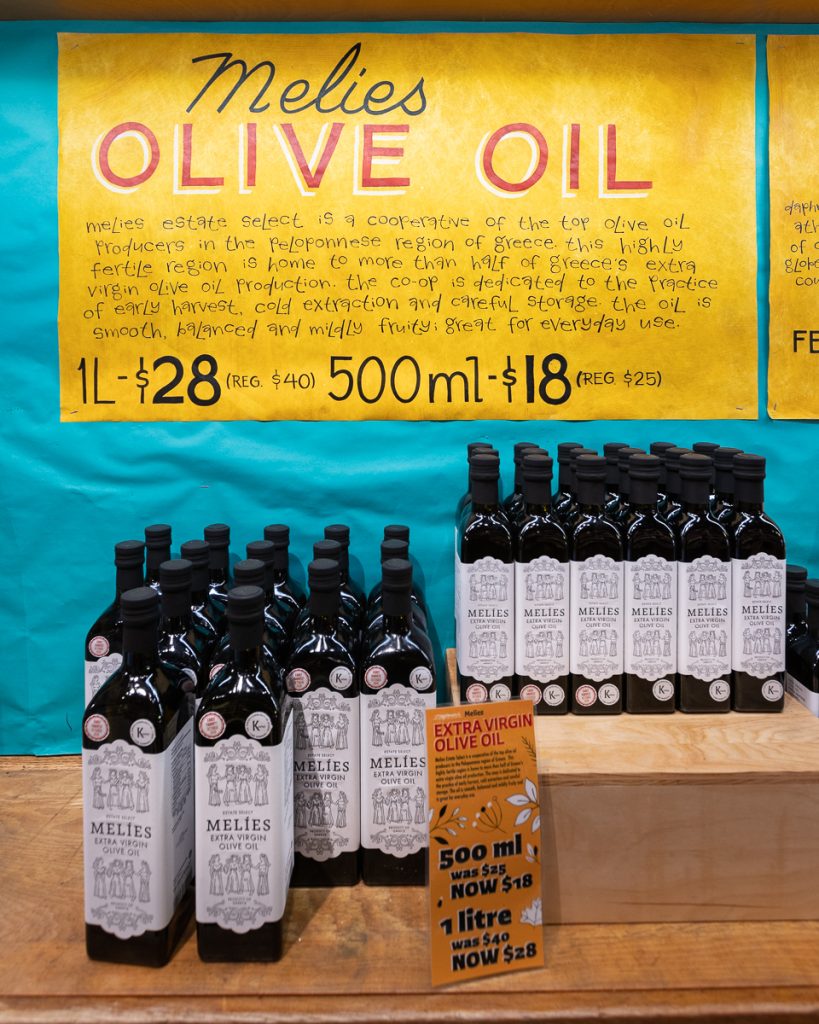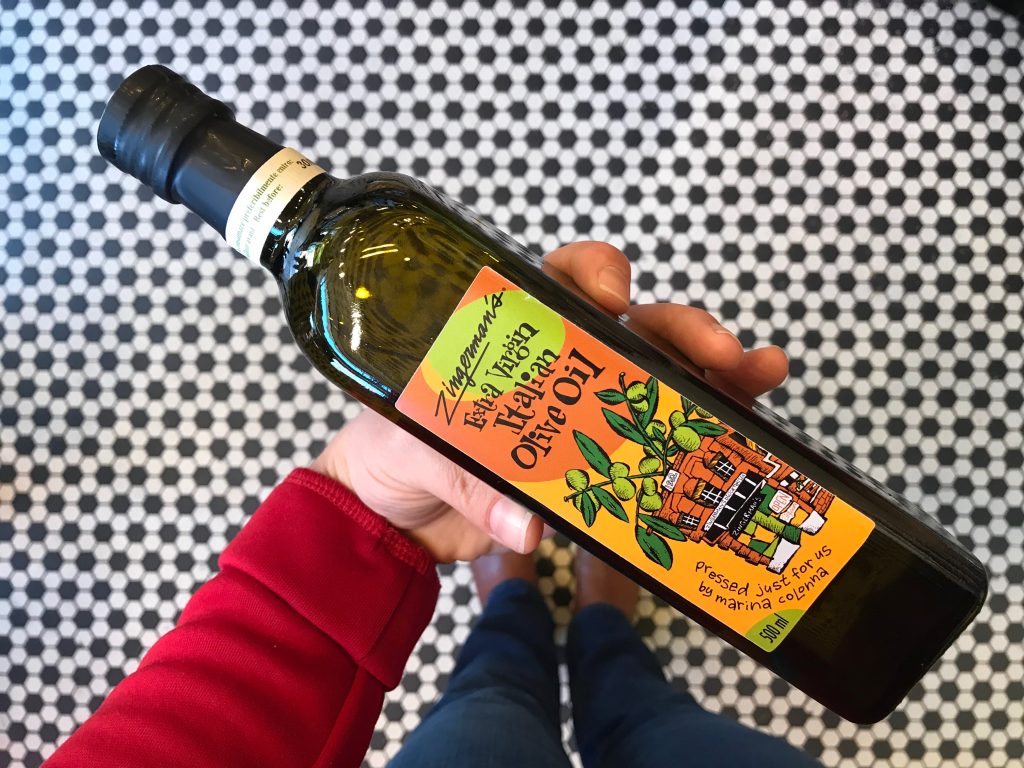Buy a Better Bottle at the Deli

Have you ever wandered around the Deli and wondered how we select the distinctive olive oils we carry? Or what makes our selection different from what you’ll find at a typical grocery store? There are a number of reasons why our selection is special, starting with the fact that we’ve been serious about good food ever since we first opened the doors to the Deli on March 15th, 1982. In fact, Ari Weinzweig, one of Zingerman’s founders, literally wrote the book on it—Zingerman’s Guide to Good Eating: How to choose the best bread, cheeses, olive oil, pasta, chocolate, and much more (Houghton Mifflin, 2003). In it, he writes:
…the way I see it, good food is for everyone. I’m firm in my conviction that you don’t have to have been born French or be an insufferable food snob to discern the difference between a well-made farmhouse cheese and a bland, rubbery factory version that bears the same name. Nor do you have to be some kind of connoisseur to tell freshly ground black pepper from the stale, prepackaged stuff most restaurants put on their tables. Armed with a little background information, a heightened sense of awareness, and a shopping bag filled with great ingredients, almost anyone can understand, prepare, and appreciate top-quality food.
We want good olive oils to be one of those top-quality items that you appreciate, too. Here are our top 8 reasons why we believe Zingerman’s olive oils are special:
We Know Extra Virgin Olive Oil
In the food world (and, as is often the case more generally, in life), increased knowledge brings increased opportunity for enjoyment. We follow a 5 step process to tasting food, the first step of which just so happens to be “Know It.” We learn as much as possible about the olive oils we carry: Where are the olives grown? How are they pressed? Who are the people behind the brand making the olive oil? We also have an olive oil sommelier on staff to help us further distinguish between mediocre olive oils and the really exceptional ones. And then, just like you’ll remember from being in school, the best way to retain knowledge is to share it with others, so we do that, too! We love talking about olive oils with guests and helping you find the perfect bottle. We often teach about it, as well. Keep your eye on our events calendar for our next session of Olive Oil 101.

Flavor Comes First
This is true for every dish we make and every product we carry—olive oils are no exception. We even have a weekly tasting meeting (We know, it’s as great as it sounds, and yes, we are hiring!). We taste all of the oils we sell before we bring them on board, following that aforementioned tasting process, and only select the best of the best.
We Stick to the Source
We work directly with the producers, so we know exactly what we’re getting, from what varieties of olives they’re growing to how the olives are pressed. We never carry large commodity olive oils that could be a blend of oils from dozens or even hundreds of different olive tree farms—there’s no way of knowing what’s inside those bottles.
Time of Year Matters
We don’t always think of olive oil in the same way we might think of produce from the farmers market, but it is an agricultural product. Thus, when and where the olives are harvested affects the flavor of the olive oil. When olives are pressed early in the season, in October or early November, Ari says, “the olives are only partially ripe, but their oils tend to be fruitier, more robust, and more peppery.” While olives that are allowed to ripen longer on the tree, into December or even January, have a “milder, softer flavor.” And, of course, it’s not just the time of year, but the location of the olive tree farms, too. Olives are native to the Mediterranean, which is likely why we tend to first think of olives grown in countries like Greece, Italy, France, Spain, and Portugal. Olives are grown in countries around the world though, including Australia, New Zealand, South Africa, Japan, Peru, Argentina, and more. And, of course, olives are grown in multiple states in the U.S., too, though the vast majority of American olives are grown in California. Perhaps not surprisingly, olives grown in warmer climates tend to ripen earlier than those grown in colder ones.

Age of the Oil
Again, as an agricultural product, freshness matters. Olive oils have a long shelf life if unopened and stored in a cool, dark cupboard, but not an indefinite one. We recommend keeping them on your shelf no more than one year from harvest and using them within 3 months after opening for optimal fresh flavor. When you shop at the Deli, you can rest assured that the bottles on our shelf are at their best. We’re always excited to taste a newly arrived oil with you or talk about when we’re expecting the next harvest.
Proper Handling
It’s best to store olive oils in cool and dark conditions, so that’s what we do. As we often say, “don’t be rude to the food!”
Traditional Oils
At Zingerman’s, we’re very focused on full-flavored, traditionally-made foods, so that’s what we look for in olive oils. We carry olive oils that are made in small quantities, using traditional methods, like hand-picking olives. As you might imagine, hand-picking olives is much more time-consuming, and accordingly, more costly. But handpicking allows for more control over the process—the olives are harvested only when ready. Ari likens the process to picking apples:
Since biblical times, olive growers more interested in cash than quality have used a variety of techniques to knock their olives off the trees, from sticks to tree-shaking machines. Mechanical means do speed up the process and save money. But they also damage the olives. Imagine dropping an apple on the floor. Three hours later it has turned brown and mush, right? Same idea. Any break in the olive’s skin will increase the odds of early arrival of rancidity in the oil.
Traditional methods don’t just apply to the picking, but the processing, too! Many quality olive oil producers used to crush their olives with heavy millstones (like the stone mills used to grind grain)—some still do! Traditionally, the resulting olive mash is then spread on mats, which are stacked and hydraulically pressed to extract the liquid. Some producers have adopted newer options, including the “sinolea” method, in which steel blades run through the mash, collecting oil that adheres to the blades, and the “continuous-press” technique which first crushes the olives with small hammers and then spins the mash in a large metal tube which separates out oil, solids, and water. No one method is necessarily better than the other, as Ari notes, “Since I’ve tasted good and bad oils produced with each technique, I’ve found that the true test is still in the taste.”
We Guarantee It
We truly love the olive oils we carry, but what matters is what you think of them. So know that there’s no risk to trying a new-to-you oil. If you don’t like it, we can help with that, just let us know.
These are our top 8 reasons why we believe Zingerman’s olive oils are really special—there’s a reason we call it liquid gold!—but we can’t begin to capture everything in one blog post. We’d love to help you find olive oils that you’re really excited about, too—come visit us and chat with our olive oil sommelier! Or:



